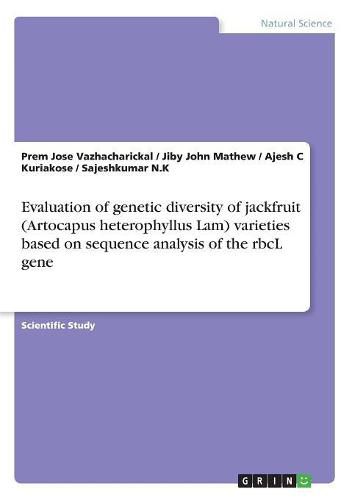Readings Newsletter
Become a Readings Member to make your shopping experience even easier.
Sign in or sign up for free!
You’re not far away from qualifying for FREE standard shipping within Australia
You’ve qualified for FREE standard shipping within Australia
The cart is loading…






Scientific Study from the year 2016 in the subject Biology - Genetics / Gene Technology, Mar Augusthinose College, language: English, abstract: Jackfruit (Artocarpus heterophyllus) is commonly grown in home gardens of tropical and sub-tropical countries. The fruit contains high levels of carbohydrates, protein, starch, calcium and vitamins. Jack fruit has diverse medicinal uses, especially anti-oxidant, anti-inflammatory, anti-microbial, anti-cancer and anti-fungal activity. Jackfruit is considered to be an underutilized fruit where most of the fruits get wasted due to ignorance, lack of post harvest technology and gaps in supply chain systems. Jackfruit contains more protein, calcium, iron, vitamins and other essential nutrients as compared to the common fruits. To find out the morphological variation among jack fruits among Kerala we conducted an elaborative survey and found out the parameters such as tree characteristics, leaf characterises or fruit characteristics of selected samples. Both qualitative and quantitative data are measured using field visits and standard methods and morphological indicators; after analysis of data there is a morphological variation among the jack fruit samples identified. Advances in the genetic markers such as RFLP and PCR based methods are more reliable for identification of genetic diversity than morphological markers although each technique has advantages and limitations. The objective of this research work was to estimate the level of genetic diversity and to assess genetic relationships among six varieties of jackfruit using the ‘rbcL gene’ based on PCR technique and RFLP markers. The partial sequence of ‘rbcL’ gene of six different Artocarpus varieties was used in the analysis. The size of amplified products was approximately 700 bp. After sequencing and sequence editing, sequence information on a 651 bp region was finally obtained for analysis. The alignment of sequences revealed two haplotypes out of 651 sites. The nu
$9.00 standard shipping within Australia
FREE standard shipping within Australia for orders over $100.00
Express & International shipping calculated at checkout
Scientific Study from the year 2016 in the subject Biology - Genetics / Gene Technology, Mar Augusthinose College, language: English, abstract: Jackfruit (Artocarpus heterophyllus) is commonly grown in home gardens of tropical and sub-tropical countries. The fruit contains high levels of carbohydrates, protein, starch, calcium and vitamins. Jack fruit has diverse medicinal uses, especially anti-oxidant, anti-inflammatory, anti-microbial, anti-cancer and anti-fungal activity. Jackfruit is considered to be an underutilized fruit where most of the fruits get wasted due to ignorance, lack of post harvest technology and gaps in supply chain systems. Jackfruit contains more protein, calcium, iron, vitamins and other essential nutrients as compared to the common fruits. To find out the morphological variation among jack fruits among Kerala we conducted an elaborative survey and found out the parameters such as tree characteristics, leaf characterises or fruit characteristics of selected samples. Both qualitative and quantitative data are measured using field visits and standard methods and morphological indicators; after analysis of data there is a morphological variation among the jack fruit samples identified. Advances in the genetic markers such as RFLP and PCR based methods are more reliable for identification of genetic diversity than morphological markers although each technique has advantages and limitations. The objective of this research work was to estimate the level of genetic diversity and to assess genetic relationships among six varieties of jackfruit using the ‘rbcL gene’ based on PCR technique and RFLP markers. The partial sequence of ‘rbcL’ gene of six different Artocarpus varieties was used in the analysis. The size of amplified products was approximately 700 bp. After sequencing and sequence editing, sequence information on a 651 bp region was finally obtained for analysis. The alignment of sequences revealed two haplotypes out of 651 sites. The nu